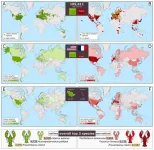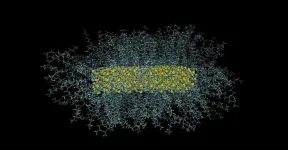Six proteins implicated in early-onset preeclampsia
2024-10-14
(Press-News.org) Preeclampsia is a life-threatening pregnancy complication marked by persistent high blood pressure that is even more serious when it occurs early in the first trimester. The exact cause of early-onset preeclampsia is unknown, and it is difficult to predict, prevent and diagnose. Now, in ACS’ Journal of Proteome Research, researchers report on six proteins that could be used as targets to diagnose and treat the condition.
Preeclampsia’s key symptom is high maternal blood pressure, and serious cases can lead to maternal organ failure, low infant birth weight, or maternal or fetal death. Preeclampsia before 34 weeks of pregnancy has a higher risk of severe outcomes, especially for the fetus. But it’s difficult for health care providers to detect this condition before harmful symptoms appear, because little is known about what causes it. So, Jing Li and colleagues set out to characterize proteins in placenta tissue that may offer clues about the cause of early-onset preeclampsia and serve as targets for early detection or treatment.
The researchers collected placenta tissue from 30 pregnant people, half with early-onset preeclampsia and half with healthy pregnancies. Li and colleagues used mass spectrometry to screen molecular fragments in each sample, followed by a software program to match the fragments to their associated proteins. This process pinpointed 59 proteins that were present in different amounts (either higher or lower) for preeclamptic placenta tissue samples versus healthy placenta tissue samples. The researchers chose 16 of these proteins to target with a different, more sensitive mass spectrometry method, which more precisely measured the amounts of each protein. Of these 16 proteins, six were present in statistically different amounts across tissue sample groups:
Preeclamptic placenta tissue had higher levels of monocarboxylate transporter 4, ERO1-like protein alpha and pappalysin-2. These proteins are involved in synthesizing proteins and regulating growth hormones.
Preeclamptic placenta tissue had lower levels of desmin, caldesmon and keratine 18. These proteins play key roles in cardiovascular complications, like an enlarged heart; blood flow in placental muscle cells; estrogen signaling and cell health in the uterus lining.
Altogether, the results suggest that cardiovascular complications or the estrogen cycle could be linked to the development of early-onset preeclampsia. The team says that more research is needed, but identifying these six proteins serves as a promising first step toward improved detection and treatment of this life-threatening condition.
The authors acknowledge funding from the Natural Science Foundation of Shandong Province.
###
The American Chemical Society (ACS) is a nonprofit organization chartered by the U.S. Congress. ACS’ mission is to advance the broader chemistry enterprise and its practitioners for the benefit of Earth and all its people. The Society is a global leader in promoting excellence in science education and providing access to chemistry-related information and research through its multiple research solutions, peer-reviewed journals, scientific conferences, e-books and weekly news periodical Chemical & Engineering News. ACS journals are among the most cited, most trusted and most read within the scientific literature; however, ACS itself does not conduct chemical research. As a leader in scientific information solutions, its CAS division partners with global innovators to accelerate breakthroughs by curating, connecting and analyzing the world’s scientific knowledge. ACS’ main offices are in Washington, D.C., and Columbus, Ohio.
Registered journalists can subscribe to the ACS journalist news portal on EurekAlert! to access embargoed and public science press releases. For media inquiries, contact newsroom@acs.org.
Note: ACS does not conduct research but publishes and publicizes peer-reviewed scientific studies.
Follow us: X, formerly Twitter | Facebook | LinkedIn | Instagram
END
ELSE PRESS RELEASES FROM THIS DATE:
2024-10-14
Artificial intelligence can help people process and comprehend large amounts of data with precision, but the modern image recognition platforms and computer vision models that are built into AI frequently overlook an important back-end feature called the alpha channel, which controls the transparency of images, according to a new study.
Researchers at The University of Texas at San Antonio (UTSA) developed a proprietary attack called AlphaDog to study how hackers can exploit this oversight. Their findings are described in a paper written by Guenevere Chen, an assistant professor in the UTSA Department of Electrical and Computer Engineering, and her former ...
2024-10-14
Freshwater crayfish, keystone species of aquatic ecosystems, are now at the center of a new tool that promises to revolutionize conservation efforts. World of Crayfish™ (WoC), a newly launched web platform, aims to provide real-time global mapping of freshwater crayfish and their pathogens, offering an invaluable resource for researchers, conservationists, and environmental stakeholders.
Published in PeerJ Life and Environment, the article, World of Crayfish™: A web platform towards real-time global mapping of freshwater crayfish and their pathogens, highlights the urgent need for accurate, up-to-date data on ...
2024-10-14
Biodiversity is in crisis. Human activities are driving species extinctions at unprecedented rates, but funding for conservation remains woefully inadequate. To address this gap, the concept of a Biodiversity Credit Market (BCM) has emerged, inspired by carbon credit systems that incentivize conservation and restoration efforts.
However, while the BCM holds promise, it risks falling into the same pitfalls as its carbon counterpart—especially if it fails to implement rigorous science-backed baselines, ...
2024-10-14
DAEJEON, South Korea (October 14, 2024) – Qunova Computing, a developer of quantum software applications designed to bring quantum computing to the chemical, pharmaceutical and industrial engineering industries, today announces the results from a series of recent tests performed on three different NISQ era quantum computers, each with a different qubit count. In each demonstration, Qunova’s algorithm was able to produce results with accuracy below the threshold of 1.6 millihartrees required for real-world quantum chemistry applications, a level known as ‘chemical ...
2024-10-14
Scientists have successfully bred corals to improve their heat tolerance
A new study has shown that selective breeding can lead to a modest rise in coral heat tolerance.
Led by experts at Newcastle University’s Coralassist Lab, the study documents the world’s first effort to selectively breed adult corals for enhanced heat tolerance, i.e. the ability of adult corals to survive intense marine heatwaves. The breeding effort was a success, showing that it is possible to improve the heat tolerance of adult coral offspring, even in a single generation.
However, the improvement was modest in comparison ...
2024-10-14
Seven of the most common forest trees in Europe have been shown to be able to shelter their genetic diversity from major shifts in environmental conditions. This is despite their ranges having shrunk and the number of trees having fallen sharply during ice age cycles. These are the findings of a study by a European consortium including Uppsala University, published in Nature Communications.
“From a biodiversity perspective, this is very positive because these trees are keystone species on which many other species depend,” says Pascal Milesi, Associate Professor of Plant Ecology and Evolution at Uppsala University and first author of the study.
The researchers aimed to investigate ...
2024-10-14
A protein that is involved in determining which enzymes cut or unwind DNA during the replication process has been identified in a new study.
In a new paper published in Nature Communications, an international team of researchers have found that the protein USP50 supports the DNA replication process by helping to decide the proper use of nucleases or helicases. These enzymes are implemented during the DNA replication process to promote ongoing replication and where the copying machinery runs into problems ...
2024-10-14
Bridging Our Political Divide collects the insights of a psychologist who offers antidotes to the unproductive arguments that now dominate our political culture and ways to find common ground.
New York, U.S./Oxford, UK, October 14, 2024 – As the 2024 US Presidential Election in November inches closer, the partisan divide in American society has never felt more apparent – or pervasive.
From workplace chatter to heated discussions at family gatherings, many Americans may have asked themselves, ‘How can I make this ...
2024-10-14
COLUMBUS, Ohio – Attention deficit/hyperactivity disorder – also known as ADHD – is typically thought of as a childhood condition. But more adults are realizing that their struggles with attention, focus and restlessness could in fact be undiagnosed ADHD, thanks in large part to trending social media videos racking up millions of views.
A new national survey of 1,000 American adults commissioned by The Ohio State University Wexner Medical Center and College of Medicine finds that 25% of adults now suspect they may have undiagnosed ADHD. But what worries mental health experts is that only 13% of survey respondents have shared their suspicions with their doctor.
That’s ...
2024-10-14
From brighter TV screens to better medical diagnostics and more efficient solar panels, new Curtin-led research has discovered how to make more molecules stick to the surface of tiny nanocrystals, in a breakthrough that could lead to improvements in everyday technology.
Lead author Associate Professor Guohua Jia from Curtin’s School of Molecular and Life Sciences, said the study investigated how the shape of zinc sulfide nanocrystals affected how well molecules, known as ligands, stick to their surface.
“Ligands, play an important role in controlling the behaviour and performance ...
LAST 30 PRESS RELEASES:
[Press-News.org] Six proteins implicated in early-onset preeclampsia





